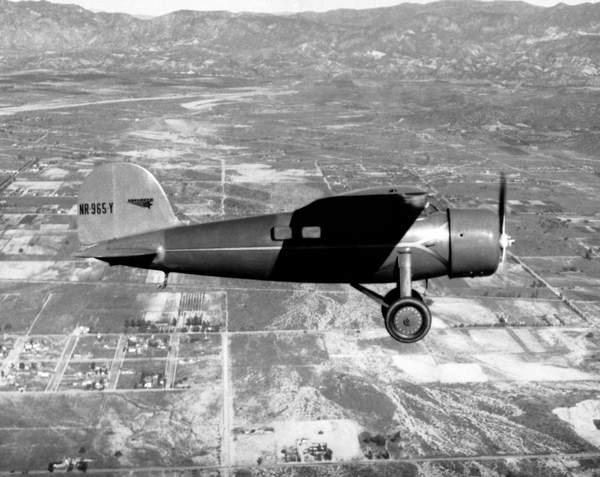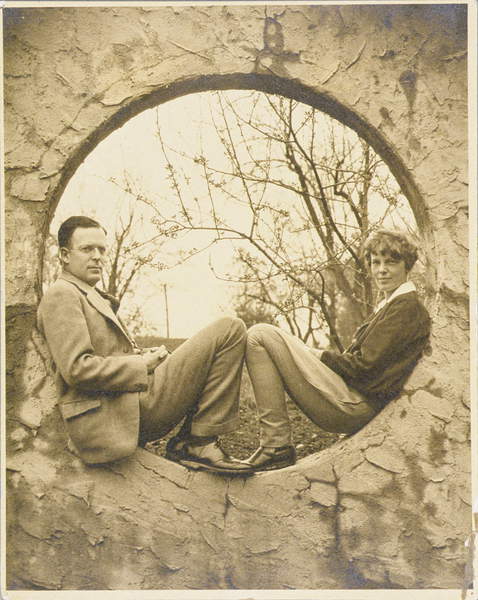
Amelia Earhart and Amy Johnson - Strong Women with wings
Strong Women Amelia Earhart and Amy Johnson have influenced women's roles in society and aviators around the world for over 90 years.
Amelia Earhart is an American pilot known around the world for redefining the roles of women in the 1920s and 1930s, breaking and setting records in the process.
 Amelia Earhart, c.late 1920s-early 1930s Bridgeman Images
Amelia Earhart, c.late 1920s-early 1930s Bridgeman Images
Earhart championed active lifestyles and a career in aviation for women. Her records include breaking the women's altitude record in 1922, becoming the first woman to fly solo across the Atlantic Ocean in 1928 and solo nonstop across the Atlantic Ocean in 1932, as well as many first flights across the United States and Mexico in the 1930s.
Earhart’s flight around the world in 1937 solidified her legacy. For the last 85 years, this journey has captivated the public, not because the trip was a success, but rather because Earhart and her navigator, Fred Noonan, vanished.
To this day Earhart, Noonan, or the Lockheed Electra plane have never been found. They started their journey in Oakland, California, 22,000 miles later they arrived in Lae, New Guinea. After Lae they were set to land and refuel on Howland Island in the Pacific Ocean but they never arrived.
Howland Island is a very small island, it is only 6,500 feet long and 1,600 feet wide. Earhart and Noonan were aware that it would not be an easy location to land so they had worked out a celestial navigation path. Before GPS systems were a standard in planes, one-way navigators were able to track location using celestial navigation, which is a way to calculate the distance from the horizon in relation to the sun, moon, or stars to calculate an exact location. In the event of overcast skies, Earhart and Noonan made sure they had a failsafe in place, the U.S. Coast Guard ship, Itasca. They would be able to maintain radio communication with Itasca as well as use it as a guide for landing on the island. Earhart and Noonan would ultimately need to rely on the Itasca because the sky was overcast and the Noonan would have been unable to accurately utilize the celestial navigation plan.
Their takeoff from Lae potentially doomed them from the start. It is thought that the plane's radio receiving antenna, which was located on the underside of the plane, was damaged when they took off. That meant that the Electra could not receive incoming radio messages from the Itasca. But the Electra was able to transmit and it got close enough to the Itasca for the Itasca to pick up Earhart’s distressed transmissions that their fuel was running low. Earhart was unable to spot the Itasca; the crew of the Itasca was unable to spot the Electra.
It also speculated that the Electra and the Itasca were keeping time from different time zones, meaning that the check-in times would not sync up, or that there was confusion as to which frequency to communicate with each other on. It is possible that even if the radio communication worked, Earhart and Noonan would have faced difficulties locating the island as Noonan’s coordinates of Howland's position were inaccurate and placed the island five or six nautical miles off.
For decades people have speculated what happened to Earhart and Noonan and what their fates were, some theories make logical sense and others seem a little far-fetched, but ultimately no one knows which one was right but them. Earhart would be declared dead on January 5, 1939.
Amelia Earhart helps test a commercial parachute. June 2, 1935. CSU ArchivesEverett Collection Bridgeman Images
The most common theory is that Earhart and Noonan simply ran out of fuel, crashed into the ocean, and sank. Others believe that the plane crashed into the ocean, Earhart and Noonan survived and made it to an uninhabited island of Nikumaroro, but were not found in time and died on the island. In 1937 and 1938 British groups visited the island with the intent to colonize it. Men from the groups claimed to have found an improvised campsite and various objects that could potentially be components from a plane. In 1940 a few bones were found as well as a men’s shoe, a woman’s shoe, and a box from a navigation device. The bones were sent off the island to Fiji where they were lost. No definitive evidence was ever found tying Earhart and Noonan to Nikumaroro.
Some speculate that the plane never crashed in the ocean because the Itasca began searching for the plane as soon as they realized there was a problem and that they had lost contact. President Franklin D. Roosevelt authorized what at that point was the most expensive air and sea search in American history, there was no debris found, or oil slicks were spotted in the ocean by planes and ships that spent two weeks searching.
If the plane did not crash in the ocean it may have landed on The Marshall Islands which were under Japanese control and hundreds of miles away from Howland Island. The Japanese captured them because they were spies or at least were thought to be spies and killed them, or landing on The Marshall Islands was a strategic plan. This allowed Earhart and Noonan to abandon their plane and provide the US government with a secret rescue mission which gave the government the cover needed for a reconnaissance mission of the Japanese island. The US government would then sneak Earhart and Noonan back into the United States where Earhart would live out her days as a New Jersey housewife named Irene Craigmile Bolam.
In 2002 and 2006 the deep-ocean search and research company Nauticos used state-of-the-art technology to search the ocean floor around Howland Island, and in 2009 the Waitt Institute sent a team to search a different area of the ocean floor around the island. All three searches turned up nothing.
View a selection of images of Amelia Earhart
Just four years after Amelia Earhart’s disappearance another world-renowned female pilot met a similar fate.
English pilot, Amy Johnson, disappeared while flying in 1941. Like Earhart, Johnson set multiple records. Her records included being the first woman to fly solo from England to Australia in 1930, and breaking speed records flying from London to Moscow, London to Tokyo, and London to Cape Town.
During World War II Johnson joined the Air Transport Auxiliary, her position there required her to shuttle planes from the factory locations to the Royal Air Force bases, bring the planes in for maintenance, or move them from base to base. It was during one of these trips on January 7, 1941, that witnesses say they saw her eject from the Airspeed Oxford plane she was flying and the plane crashed into the Thames estuary.
She was almost 100 miles off course from RAF Kidlington in Oxfordshire where she was supposed to land the plane. The Haslemere, a ship in the area, threw lines for Johnson to grab but she was unable to grasp them. The ship's commanding officer jumped into the frigid water to try his hand at rescuing her.
His attempt was unsuccessful and required rescue himself after succumbing to the hypothermia that would ultimately kill him a few days later. Johnson’s body was never recovered and some witnesses claimed to have seen a second body in the water even though Johnson had taken off for the flight alone.
Just like Earhart’s final flight, visibility was poor, Johnson was competing against fog and cold temperatures potentially causing icing on the plane. The theories as to what happened are similar to Earhart’s, some suspect that she attempted to fly above the fog, as a result, she lost track of her location and ran out of gas, causing her to crash into the water.
Others claim that twice she failed to relay the correct identification code over the radio and her plane was shot down over fear that it was a Nazi aircraft. When it was discovered who was shot down, the gunmen involved were told to keep the incident to themselves for fear of hurting morale in the country. There is also speculation that when the Haslemere attempted their rescue mission she got pulled into the Haslemere’s propellers which killed her.
Despite their tragic ends, Amelia Earhart and Amy Johnson have influenced women and aviators around the world for over 90 years. They were leaders in redefining the roles of women in society and provided motivation for women to pressure their passions.

%2c%20posting%20in%20front%20of%20the%20propeller%20of%20her%20Lockheed%20L-10E%20Electra%20on%20July%208%2c%201937%2c%20on%20land%20during%20a%20stop%20in%20her%20final%20round-the-world%20flight%20which%20began%20from%20Miami%2c%20Florida%2c%20in%20June%201%20.jpeg?width=485&name=Asset%20-%20Amelia%20Earhart%20(1897-1937)%2c%20posting%20in%20front%20of%20the%20propeller%20of%20her%20Lockheed%20L-10E%20Electra%20on%20July%208%2c%201937%2c%20on%20land%20during%20a%20stop%20in%20her%20final%20round-the-world%20flight%20which%20began%20from%20Miami%2c%20Florida%2c%20in%20June%201%20.jpeg)

%20looking%20at%20charts%2c%201936%20(bw%20photo)%2c%20American%20Photographer%2c%20(20th%20century)%20%20Schlesinger%20Library%2c%20Radcliffe%20Institute%2c%20Harvard%20University%20%20%C2%A9%20Schlesinger%20Library%2c%20Radcliffe%20Institute%2c%20Harvard%20%20Bridgeman%20Images%20.jpeg?width=600&name=Amelia%20Earhart%20(1897-1937)%20looking%20at%20charts%2c%201936%20(bw%20photo)%2c%20American%20Photographer%2c%20(20th%20century)%20%20Schlesinger%20Library%2c%20Radcliffe%20Institute%2c%20Harvard%20University%20%20%C2%A9%20Schlesinger%20Library%2c%20Radcliffe%20Institute%2c%20Harvard%20%20Bridgeman%20Images%20.jpeg)


%2c%20American%20Photographer%2c%20(20th%20century)%20%20Schlesinger%20Library%2c%20Radcliffe%20Institute%2c%20Harvard%20University%20%20%C2%A9%20Schlesinger%20Library%2c%20Radcliffe%20Institute%2c%20Harvard%20%20Bridgeman%20Images%20.jpeg?width=600&name=Amelia%20Earhart%2c%201932%20(bw%20photo)%2c%20American%20Photographer%2c%20(20th%20century)%20%20Schlesinger%20Library%2c%20Radcliffe%20Institute%2c%20Harvard%20University%20%20%C2%A9%20Schlesinger%20Library%2c%20Radcliffe%20Institute%2c%20Harvard%20%20Bridgeman%20Images%20.jpeg)

%2c%20American%20Photographer%2c%20(20th%20century)%20%20Private%20Collection%20%20J.%20T.%20Vintage%20%20Bridgeman%20Images%20.jpeg?width=600&name=Amelia%20Earhart%2c%20c.%201937%20(bw%20photo)%2c%20American%20Photographer%2c%20(20th%20century)%20%20Private%20Collection%20%20J.%20T.%20Vintage%20%20Bridgeman%20Images%20.jpeg)
%2c%20English%20Photographer%2c%20(20th%20century)%20%20Private%20Collection%20%20Look%20and%20Learn%20%20Elgar%20Collection%20%20Bridgeman%20Images%202.jpeg?width=600&name=Amy%20Johnson%2c%20British%20aviator%20(bw%20photo)%2c%20English%20Photographer%2c%20(20th%20century)%20%20Private%20Collection%20%20Look%20and%20Learn%20%20Elgar%20Collection%20%20Bridgeman%20Images%202.jpeg)

%2c%20English%20Photographer%2c%20(20th%20century)%20%20Private%20Collection%20%20%C2%A9%20Look%20and%20Learn%20%20Bridgeman%20Images%20.jpeg?width=425&name=Amy%20Johnson%20after%20the%20mishap%20at%20Insein%2c%20Burma%201932%20(bw%20photo)%2c%20English%20Photographer%2c%20(20th%20century)%20%20Private%20Collection%20%20%C2%A9%20Look%20and%20Learn%20%20Bridgeman%20Images%20.jpeg)
%2c%20English%20Photographer%2c%20(20th%20century)%20%20Private%20Collection%20%20Look%20and%20Learn%20%20Elgar%20Collection%20%20Bridgeman%20Images%20.jpeg?width=381&name=Amy%20Johnson%2c%20British%20aviator%20(bw%20photo)%2c%20English%20Photographer%2c%20(20th%20century)%20%20Private%20Collection%20%20Look%20and%20Learn%20%20Elgar%20Collection%20%20Bridgeman%20Images%20.jpeg)
%20English%20aviator%2c%20about%20to%20set%20out%20for%20Cape%20Town%201932.%20Johnson%20saying%20goodbye%20to%20her%20husband%2c%20fellow%20pilot%20James%20Mollison%2c%20before%20starting%20off..jpeg?width=600&name=Amy%20Johnson%20(1903-1941)%20English%20aviator%2c%20about%20to%20set%20out%20for%20Cape%20Town%201932.%20Johnson%20saying%20goodbye%20to%20her%20husband%2c%20fellow%20pilot%20James%20Mollison%2c%20before%20starting%20off..jpeg)
%20and%20James%20Allan%20Mollison%20(1905-59)%20inspecting%20their%20plane%20(b%26w%20photo)%2c%20English%20Photographer%2c%20(20th%20century)%20%20Private%20Collection%20%20Bridgeman%20Images%20.jpeg?width=600&name=Amy%20Johnson%20(1903-41)%20and%20James%20Allan%20Mollison%20(1905-59)%20inspecting%20their%20plane%20(b%26w%20photo)%2c%20English%20Photographer%2c%20(20th%20century)%20%20Private%20Collection%20%20Bridgeman%20Images%20.jpeg)

%2c%20Capstack%2c%20John%20(1881-1967)%20%20Private%20Collection%20%20Prismatic%20Pictures%20%20Bridgeman%20Images%20.jpeg?width=441&name=Portrait%20of%20Amy%20Johnson%2c%20c.1933-35%20(bw%20photo)%2c%20Capstack%2c%20John%20(1881-1967)%20%20Private%20Collection%20%20Prismatic%20Pictures%20%20Bridgeman%20Images%20.jpeg)